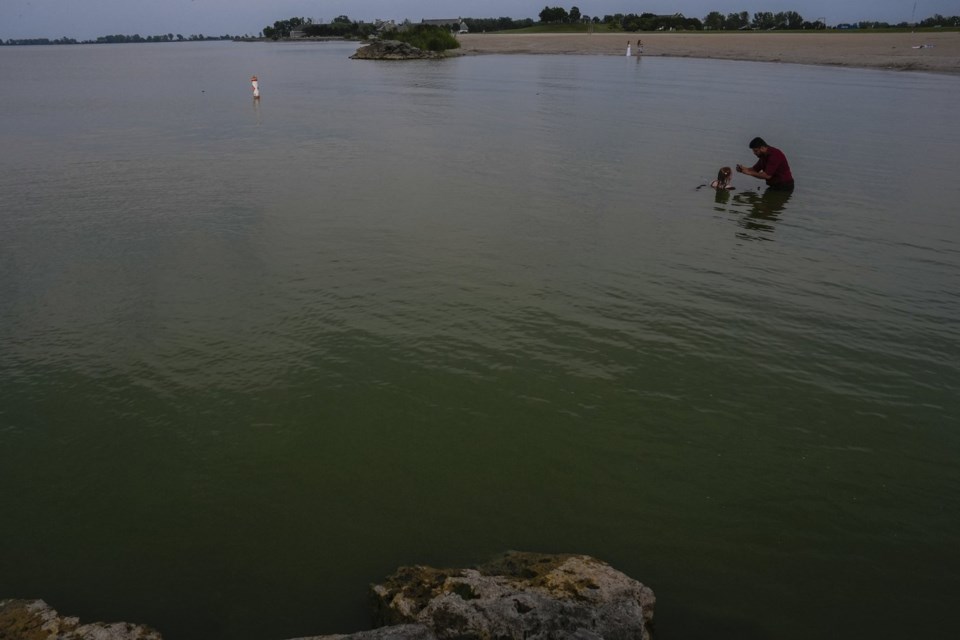TOLEDO, Ohio (AP) — Steven Haller remembers the look of fear on people's faces when toxic algae in Lake Erie made it into his community's water supply 10 years ago, shutting it down for two days.
Since then, Haller, a clinical researcher in the University of Toledo's department of medicine, has set out to help provide answers about how harmful algal blooms can affect the health of people who live and play nearby.
“I see all of the concern in the faces of people here," Haller said. “They want the answers. They want to know."
For residents in Lake Erie's western basin, the blooms are a common sight. As spring rains push excess nutrients off farm fields and into the creeks and rivers of the watershed, the bacteria that live in the lake feed on that phosphorus and nitrogen, tinting the water green, producing a thick sludge when severe and potentially turning toxic to humans and animals.
Research has shown that toxins from these bacteria called microcystin can make animals and people sick when they come into contact with infected water. At Haller's lab, researchers hope to better understand how these toxins affect people, especially those with health conditions like asthma.
At the lab, which Haller manages along with David Kennedy, an associate professor of medicine, researchers are examining how microcystin affect people with health conditions such as liver, gut or lung diseases by growing cell samples and exposing the cells to the toxin.
“We've shown that in all those instances, exposure to microcystin makes the disease process worse,” Haller said.
One new area of study here is the effects of the toxins when aerosolized — that is, made airborne. In the lab, scientists use a machine that uses high pressure to spray toxin onto human lung cells. At the lake, the toxins could aerosolize as waves hit rocks on shore or as boats and personal watercraft churn through the water.
Monitoring the air near Lake Erie is key to understanding how the toxins can get aerosolized.
On a warm afternoon around the peak of a bloom near Toledo, Kennedy climbed a ladder about 15 feet onto the top of a small concrete building near shore where an air monitor was collecting and filtering air from the lake. Kennedy installed a clean air filter after collecting the previous week's, stained a light gray from airborne particles.
The sampling runs through the end of the bloom season, possibly through November, Kennedy said. After that, all the filters will be analyzed. It's the first year they've conducted this research on Erie, but their work follows peer-reviewed research published in 2023 that at Grand Lake St. Mary's, Ohio.
While Kennedy and Haller are waiting to see if microcystin is in the air near Lake Erie, they have initial results from their controlled experiments that show inflammation in lung cells increases when exposed to these aerosolized toxins. For asthma, it increases “significantly,” Haller said.
Some residents of Toledo said they've gotten used to taking precautions against the algae.
“When it starts getting like this, it’s bottled water for everything," said Malissa Vallestero, who was fishing with family at a park on Lake Erie during this year's bloom. “I don’t really drink the water that comes from here anymore.”
Dan Desmond, who was walking along the beach at Maumee Bay State Park with his grandnephew, said he checks on the bloom before getting near the lake.
“If I was coming down to go in the water, it would definitely ruin my day,” he said.
Along with their lab studies, Haller and Kennedy are enrolling community members in a study in collaboration with the University of Michigan. Over the next five years, they hope to study 200 people to see if algal blooms affect their health. Researchers will ask participants questions about their health during the course of the algal bloom season, run lung tests, take blood samples and try to quantify toxins in their bodies if they have them.
“I want to be able to provide those answers both ways, whether there’s an effect or there isn’t,” Haller said.
‚Äî‚∂ƒî
Follow Joshua A. Bickel on and at @joshuabickel.
‚Äî‚∂ƒî
The Associated Press’ climate and environmental coverage receives financial support from multiple private foundations. AP is solely responsible for all content. Find AP’s for working with philanthropies, a list of supporters and funded coverage areas at .
Joshua A. Bickel, The Associated Press



